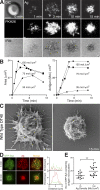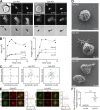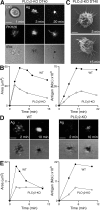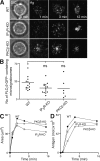Phospholipase C-gamma2 and Vav cooperate within signaling microclusters to propagate B cell spreading in response to membrane-bound antigen
- PMID: 18362175
- PMCID: PMC2292224
- DOI: 10.1084/jem.20072619
Phospholipase C-gamma2 and Vav cooperate within signaling microclusters to propagate B cell spreading in response to membrane-bound antigen
Erratum in
- J Exp Med. 2008 May 12;205(5):1243
Abstract
B cell receptor (BCR) recognition of membrane-bound antigen initiates a spreading and contraction response, the extent of which is controlled through the formation of signaling-active BCR-antigen microclusters and ultimately affects the outcome of B cell activation. We followed a genetic approach to define the molecular requirements of BCR-induced spreading and microcluster formation. We identify a key role for phospholipase C-gamma2 (PLCgamma2), Vav, B cell linker, and Bruton's tyrosine kinase in the formation of highly coordinated "microsignalosomes," the efficient assembly of which is absolutely dependent on Lyn and Syk. Using total internal reflection fluorescence microscopy, we examine at high resolution the recruitment of PLCgamma2 and Vav to microsignalosomes, establishing a novel synergistic relationship between the two. Thus, we demonstrate the importance of cooperation between components of the microsignalosome in the amplification of signaling and propagation of B cell spreading, which is critical for appropriate B cell activation.
Figures







Similar articles
-
CD19 amplifies B lymphocyte signal transduction by regulating Src-family protein tyrosine kinase activation.J Immunol. 1999 Jun 15;162(12):7088-94. J Immunol. 1999. PMID: 10358152
-
Syk mediates BCR- and CD40-signaling integration during B cell activation.Immunobiology. 2011 May;216(5):566-70. doi: 10.1016/j.imbio.2010.09.016. Epub 2010 Oct 7. Immunobiology. 2011. PMID: 21074890 Free PMC article.
-
Stimulation of Src family protein-tyrosine kinases as a proximal and mandatory step for SYK kinase-dependent phospholipase Cgamma2 activation in lymphoma B cells exposed to low energy electromagnetic fields.J Biol Chem. 1998 Feb 13;273(7):4035-9. doi: 10.1074/jbc.273.7.4035. J Biol Chem. 1998. PMID: 9461594
-
The B-cell antigen receptor: formation of signaling complexes and the function of adaptor proteins.Curr Top Microbiol Immunol. 2000;245(1):53-76. doi: 10.1007/978-3-642-57066-7_2. Curr Top Microbiol Immunol. 2000. PMID: 10533310 Review. No abstract available.
-
Regulation of the phospholipase C-gamma2 pathway in B cells.Immunol Rev. 2000 Aug;176:19-29. doi: 10.1034/j.1600-065x.2000.00605.x. Immunol Rev. 2000. PMID: 11043765 Review.
Cited by
-
Toll-like receptor ligands sensitize B-cell receptor signalling by reducing actin-dependent spatial confinement of the receptor.Nat Commun. 2015 Feb 3;6:6168. doi: 10.1038/ncomms7168. Nat Commun. 2015. PMID: 25644899 Free PMC article.
-
BTK inhibitors in the treatment of hematological malignancies and inflammatory diseases: mechanisms and clinical studies.J Hematol Oncol. 2022 Oct 1;15(1):138. doi: 10.1186/s13045-022-01353-w. J Hematol Oncol. 2022. PMID: 36183125 Free PMC article. Review.
-
Rac-mediated Stimulation of Phospholipase Cγ2 Amplifies B Cell Receptor-induced Calcium Signaling.J Biol Chem. 2015 Jul 10;290(28):17056-72. doi: 10.1074/jbc.M115.645739. Epub 2015 Apr 22. J Biol Chem. 2015. PMID: 25903139 Free PMC article.
-
The actin cytoskeleton coordinates the signal transduction and antigen processing functions of the B cell antigen receptor.Front Biol (Beijing). 2013 Oct;8(5):475-485. doi: 10.1007/s11515-013-1272-0. Front Biol (Beijing). 2013. PMID: 24999354 Free PMC article.
-
Actin reorganization is required for the formation of polarized B cell receptor signalosomes in response to both soluble and membrane-associated antigens.J Immunol. 2012 Apr 1;188(7):3237-46. doi: 10.4049/jimmunol.1103065. Epub 2012 Mar 2. J Immunol. 2012. PMID: 22387556 Free PMC article.
References
-
- Dal Porto, J.M., S.B. Gauld, K.T. Merrell, D. Mills, A.E. Pugh-Bernard, and J. Cambier. 2004. B cell antigen receptor signaling 101. Mol. Immunol. 41:599–613. - PubMed
-
- Reth, M., and J. Wienands. 1997. Initiation and processing of signals from the B cell antigen receptor. Annu. Rev. Immunol. 15:453–479. - PubMed
-
- DeFranco, A.L. 1997. The complexity of signaling pathways activated by the BCR. Curr. Opin. Immunol. 9:296–308. - PubMed
-
- Fruman, D.A., A.B. Satterthwaite, and O.N. Witte. 2000. Xid-like phenotypes: a B cell signalosome takes shape. Immunity. 13:1–3. - PubMed
-
- DeFranco, A.L. 2001. Vav and the B cell signalosome. Nat. Immunol. 2:482–484. - PubMed
Publication types
MeSH terms
Substances
Grants and funding
LinkOut - more resources
Full Text Sources
Molecular Biology Databases
Miscellaneous

